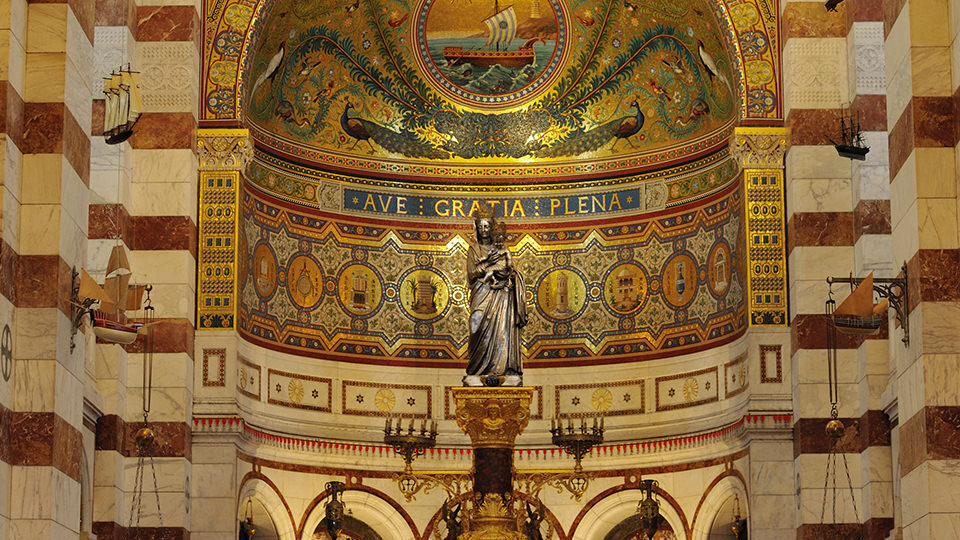

Marian Prayer with the Diocesan Clergy: Greeting of His Holiness
Pope Francis
Friday, September 22, 2023

Sanctuary of the Basilica of Notre Dame de La Garde, Marseille. iStock Photo.
Pope Francis began his Apostolic Visit to Marseille with a service of Marian Prayer with clergy of the Archdiocese of Marseille and others. He told them that "Like Mary, who at Cana first took on and then brought before the Lord the concerns of two young newlyweds (cf. John 2:3), you too are called to be a voice of intercession for others – men and women for others (cf. Romans 8:34)."
Read the full text of his address below:
Marian Prayer with the Diocesan Clergy Greeting of His Holiness
Basilica of Notre Dame de la Garde, Marseille Friday, 22 September, 2023
Dear brothers and sisters, good afternoon!
I am happy to begin my visit by sharing this moment of prayer with you. I thank Cardinal Jean-Marc Aveline for his words of welcome, and I greet Archbishop Eric de Moulins-Beaufort, my brother Bishops, the Rectors and all of you – priests, deacons, seminarians, and consecrated men and women – who work in this Archdiocese with generosity and dedication to build a society of encounter with God and neighbour. Thank you for your presence, your service and your prayers!
In coming to Marseille, I find myself in the company of great pilgrims: Saints Thérèse of the Child Jesus, Charles de Foucauld, and John Paul II, and so many others who came here to entrust themselves to “Notre Dame de la Garde.” We place under her mantle the fruit of the Rencontres Méditerranéennes, together with the expectations and hopes of your hearts.
In the biblical reading, the prophet Zephaniah exhorted us to joy and confidence, reminding us that the Lord our God is not far away, he is here, near to us, in order to save us (cf. 3:17). In a way, this message reminds us of the history of this Basilica and what it represents. In fact, it was not founded in memory of a miracle or a particular apparition, but simply because, since the thirteenth century, the holy People of God have sought and found here, on the hill of La Garde, the presence of the Lord through the eyes of his Holy Mother. That is why, for centuries, the people of Marseille – especially those who navigate the waves of the Mediterranean – have been coming up here to pray. It was the holy and faithful People of God who – I will use the word – “anointed” this sanctuary, this place of prayer. The holy People of God who, as the Council says, are infallible in credendo.
Still today, the Bonne Mère brings about for all people a very tender “intersection of gazes”: the first is that of Jesus, to whom Mary always directs our attention and whose love is reflected in her eyes – Our Lady’s most authentic gesture is “Do what he tells you,” indicating Jesus. The other gaze is that of countless men and women of all ages and conditions. She gathers them all together and brings them to God, as we recalled at the beginning of this prayer, placing a lighted candle at Our Lady’s feet. Marseille is a veritable meeting point of peoples, and it is precisely on this intersection of gazes that I would like to reflect with you, because it seems to express well the Marian dimension of our ministry. In fact, we priests, consecrated persons, and deacons are also called to help people sense the gaze of Jesus and, at the same time, to bring the gaze of our brothers and sisters to Jesus. An exchange o gazes. In the former, we are bearers of mercy, in the latter, intercessors.
The first gaze: that of Jesus which tenderly caresses all men and women. He looks intently at us from head to toe, not to judge, but to lift up those who are lowly. His gaze is full of the tenderness that shines in Mary’s eyes. And we, who are called to reflect this gaze, are compelled to become humble, so that in compassion – I want to highlight this word, compassion, for we should not forget that God’s style is that of closeness, compassion, and tenderness – we can make our own “the encouraging benevolence of the Good Shepherd, who does not reprove the lost sheep, but carries it on his shoulders and celebrates for its return to the fold (cf. Luke 15:4-7)” (Congregation for the Clergy, Directory for the Ministry and Life of Priests #30). I like to think that the Lord does not know how to point a finger to judge, but he knows how to extend a hand in order to lift up.
Brothers and sisters, let us learn from this gaze, let us not allow a day to pass without remembering when we ourselves have felt it rest upon us, and let us make it our own, so we can be men and women of compassion. Closeness, compassion, and tenderness. Let us not forget this. Being compassionate means being close and showing tenderness. Let us open the doors, not only of churches and rectories, but especially of the heart, to show through our meekness, kindness, and acceptance the face of our Lord. Whoever approaches you must not find aloofness or judgement, but the testimony of a humble joy, more fruitful than any display of ability. May people wounded by life find a safe harbour and a welcome in your gaze, encouragement in your embrace, and a caress in your hands, which is capable of wiping away their tears. Even with all the many daily concerns, I beg you, do not detract from the warmth of God’s paternal and maternal gaze. And I would say to priests: please, in the Sacrament of Penance, forgive always, forgive! Through God’s forgiveness, many paths in life are opened. It is marvelous to generously dispense his forgiveness, that is, to always, always, loosen the chains of sin through grace and free people from those obstacles, regrets, grudges, and fears against which they cannot prevail alone. It is beautiful to rediscover with wonder, at every age, in happy and sad moments, the joy of illuminating lives through the Sacraments, and of transmitting, in the name of God, unexpected hopes for his consoling presence, healing compassion, and moving tenderness. Closeness, compassion, and tenderness. Be close to all, especially the frail and less fortunate, and never let those who suffer lack your attentive and discreet closeness. In this way, there will grow in them and also in you the faith that animates the present, the hope that opens to the future and the charity that lasts forever. This is the first step: bring the gaze of Jesus to your brothers and sisters. There is only one situation in life when it is permissible to look down on a person: it is when we try to take them by the hand to lift them up. In other situations it is a sin of pride. Look at those who are down and who with their hands – consciously or unconsciously – are asking you to lift them up. Take them by the hand and lift them up: this is a very beautiful gesture, one that cannot be done without tenderness.
Then, there is the second gaze: that of men and women who turn to Jesus. Like Mary, who at Cana first took on and then brought before the Lord the concerns of two young newlyweds (cf. John 2:3), you too are called to be a voice of intercession for others – men and women for others (cf. Romans 8:34). In this way, the recitation of the Breviary, daily meditation on the Word, the Rosary, and every other prayer – I recommend especially that of adoration, for today we have lost the meaning of adoration a little bit and we need to get it back, so I recommend it to you – all these forms of prayer will be crowded with the faces of those whom Providence places on your path. You will bring with you their eyes, voices, and questions to the Eucharistic Table, before the tabernacle or to the silence of your room, where the Father sees you (cf. Mattew 6:6). You will be their faithful echo as intercessors, “angels on earth,” that is, messengers, who bring everything “before the glory of the Lord” (Tobit 12:12).
I would like to summarize this brief meditation by drawing your attention to three images of Mary which are venerated in this basilica. The first is the large image that towers over its summit; it depicts her holding the Child Jesus in the act of blessing. Like Mary, let us bring the blessing and peace of Jesus everywhere, in every family and heart. Sow peace! It is the gaze of mercy. The second image is below us in the crypt: it is the “Virgin of the Bouquet,” a gift from a generous layman. She too carries the Child Jesus in one arm and shows him to us, but in the other hand, instead of a sceptre, she holds a bouquet of flowers. It makes us think of how Mary, model of the Church, while she presents her Son to us, also presents us to him, like a bouquet of flowers in which each person is unique: this is beautiful and precious in the eyes of the Father. It is the gaze of intercession. This is very important: intercession. First was Our Lady’s merciful gaze; second, her gaze of intercession. Finally, the third image is the one we see here in the centre, on the altar, which is striking for the splendour it radiates. We too, dear brothers and sisters, become a living Gospel to the extent that we go out of ourselves to share it, reflecting its light and beauty with a humble, joyful life, rich in apostolic zeal. May the many missionaries who set out from this lofty place to proclaim the good news of Jesus Christ to the whole world be a source of encouragement to us.
Dear friends, let us bring God’s gaze to our brothers and sisters, let us bring their thirst to God, let us spread the joy of the Gospel. This is our life, and despite hardships and failures and also our sins, it is incredibly beautiful. Let us pray together to Our Lady, that she may accompany us and keep us. And please, pray for me.
Related Articles:
<<













